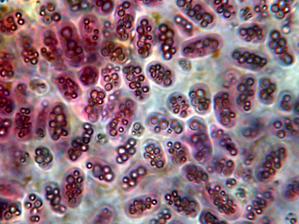Chromatium: Difference between revisions
| Line 21: | Line 21: | ||
=Ecology and Significance= | =Ecology and Significance= | ||
Little is known about the photosynthetic purple sulfur bacteria They may represent one of the most primitive photosynthetic organisms that are capable of carbon fixation. Researchers hope to sequence nine type strains of purple sulfur bacteria in hopes. | Little is known about the photosynthetic purple sulfur bacteria They may represent one of the most primitive photosynthetic organisms that are capable of carbon fixation. Researchers hope to sequence nine type strains of purple sulfur bacteria in hopes that it will provide a better understanding of the process of photosynthesis in these organisms as well as an overall process. Genomic information will also provide insight to the intricacies of global carbon and sulfur cycles. additionally, some of these bacteria may be members of the phototrophic mats in geothermal environments, playing a key role in the microbial communities. [4] | ||
=Genome Structure= | =Genome Structure= | ||
Revision as of 20:23, 11 May 2015
Classification
Domain: Bacteria Phylum: Proteobacteria Class: Gammaproteobacteria Order: Chromatiales Family: Chromatiaceae Genus: Chromatium Species: Chromatium okenii
Description
[F1]
Chromatium were first described by Swiss botanist, Maximilian Perty, in 1852. He introduced the genus name and called them "pgiment bacteria". Theodor W. Engelmann first cultured and experimented with these bacteria to discover the light excitation of the purple bacteria in 1883.
Chromatium is a gram negative bacteria found in marine environments. They tend to be flagellated straight rod shaped or even slightly curved rods of ~1 µm in diameter and 3-4 µm long.[3] These bacteria belong to the purple photosynthetic sulfur bacteria that oxidize sulfide into sulfur which is deposited in intracellular granules in their cytoplasm.[2]
Ecology and Significance
Little is known about the photosynthetic purple sulfur bacteria They may represent one of the most primitive photosynthetic organisms that are capable of carbon fixation. Researchers hope to sequence nine type strains of purple sulfur bacteria in hopes that it will provide a better understanding of the process of photosynthesis in these organisms as well as an overall process. Genomic information will also provide insight to the intricacies of global carbon and sulfur cycles. additionally, some of these bacteria may be members of the phototrophic mats in geothermal environments, playing a key role in the microbial communities. [4]
Genome Structure
Metabolism
These bacteria grow photolithoautotrophically, photolithoheterotrophically, and/or photoorganogeterotrophically.
They grow in the presence of light under anaerobic conditions. They can grow on an inorganic medium using CO2 as the sole carbon source in the presence of reduced inorganic sulfur. They use sulfur and sulfide as sole photosynthetic electron donor. Purple sulfur bacteria have to fix CO2 in order to grown and survive.
Chromatium can perform anoxygenic photosynthesis and contain bacteriochlorophyll a and carotenoids of spirilloxanthin group.
References
[1] Golyshin, Peter N. “Genome Sequence Completed of Alcanivorax borkumensis, a Hydrocarbon-degrading Bacterium That Plays a Global Role in Oil Removal from Marine Systems.” 3 (2003): 215-20. Print.
[2] Neyra, Carlos A. Carbon Metabolism. Boca Raton, FL: CRC Pr., 1985. Web. 11 May 2015.
[3] "Bacterial Metabolism & Photosynthesis." Bacterial Photosynthesis. N.p., n.d. Web. 11 May 2015.
Figures
[F1]
Author
Page authored by Sukhwinder Kaur, student of Prof. Katherine Mcmahon at University of Wisconsin - Madison.

